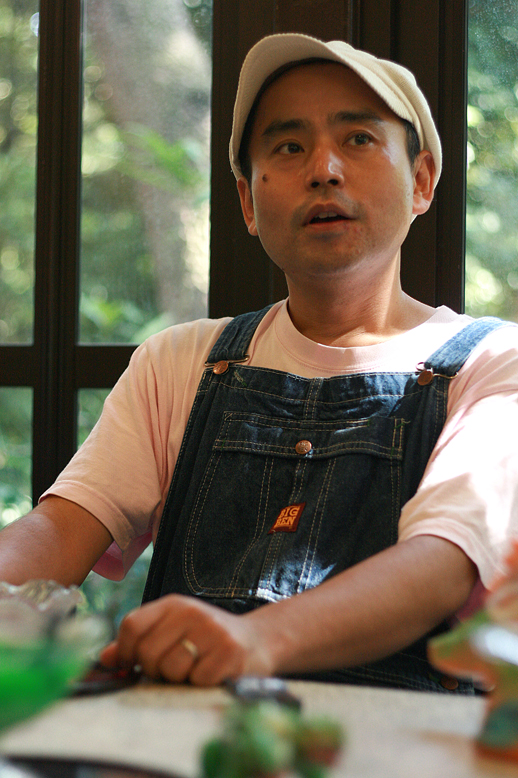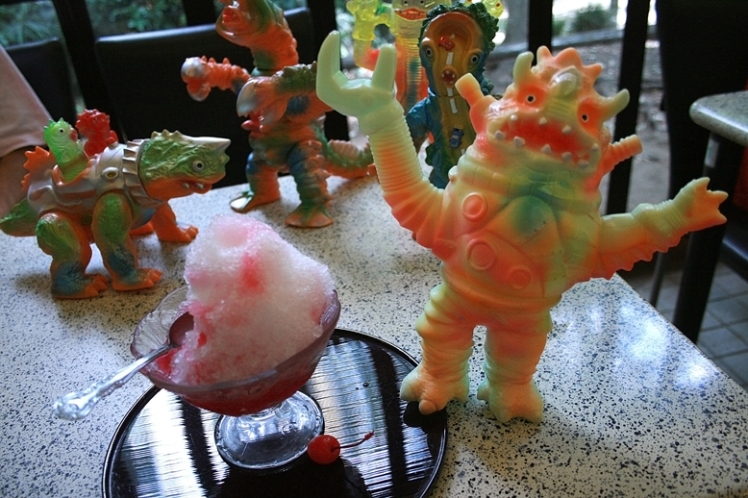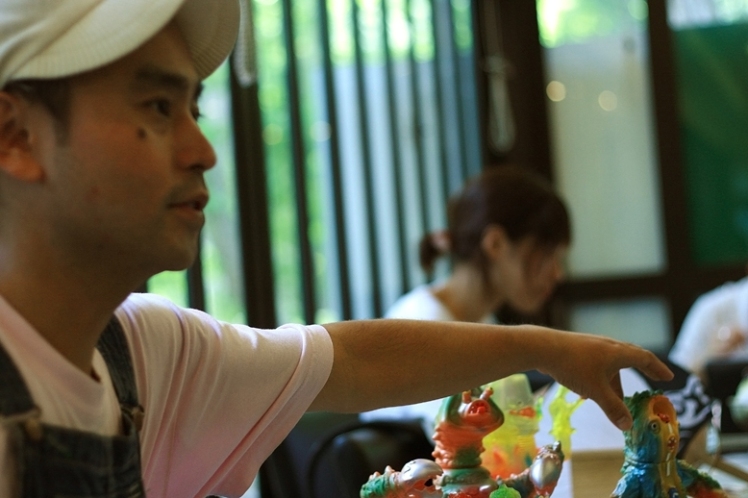Interview posted on September 6th, 2010 / 平成22年9月6日

A: When did you start making toys?
N: I started making toys 3 years ago? Yeah, 3 years ago.
A: What was the first toy you made?
N: Dokuro Tarou. He was a test, and I wasn’t sure how he’d come out. I never imagined that I would be making so many toys.
A: Why did you start making toys?
N: At first, I wanted to make Kaiju toys. Kaiju toys had the best shape, and vinyl was the best material to make Kaiju toys. So I started making toys.
A: What were the challenges with making your first toy?
N: The biggest challenge was capital.
A: Capital?
N: Money (laughs). The cost of making toys is really high. There are other difficulties with making a toy, but the first and most difficult is raising enough money. That’s why it’s the biggest challenge.
A: What steps do you go through to make a toy?
N: Hmm, to start with, I sleep. And dream. I dream about Kaiju, and when I wake up, I draw them (laughs). I have no idea what I’ll dream of, so it’s a surprise for me. I’ll start with a rough sketch, then slowly add more details. In my dreams, my Kaiju aren’t consistent, and everything is a bit chaotic. When I wake up, I immediately start to forget the details, so I have to amend them later. That’s how I get the basic character idea. From the rough sketch, I’ll draw it again in color with colored pencils. Here’s when I have to start imagining the character as a toy. Then I have a final image of the character that I can easily turn into a toy. Turning the character into a toy is the second stage.
I model the character, send it to the factory, and have it made in vinyl. That’s about it.
A: How long does this whole process take?
N: How long? Hmm, it’s different each time. Sometimes it takes a long time, sometimes it doesn’t take long at all. From the very first dream to the final toy, it might take about 2 or 3 months.
A: Do you sculpt your toys yourself?
N: Yeah, I do. I do everything myself.
A: What do you use? Wax? Sculpey?
N: I use clay. Simple, basic clay.
A: What’s your favorite Elegab toy?
N: Probably this one. Tonneran.
A: Mine too.
N: This toy had very little changes from my first idea. He’s direct from my dream.
A: What’s your most popular toy?
N: Also Tonneran. I think it’s because he’s a mixture of something real (tunnel), and something absolutely imaginary (Kaiju). I think that there are very few monsters like this.
A: Why did you choose the name Elegab?
N: Well, I draw manga, and on this manga website that I made, I used the name Elegab. So I just kept using the name.
A: Do you often participate in toy shows?
N: Nope. If you only sell toys at shows, you really limit your customers. At a toy show, you can have a lot of people view your works, but a website is much better. Actually, I think only selling through a website is best.
A: Do you currently collect toys?
N: Ah, no no no. I don’t.
A: You only have your own toys?
N: Yeah. If I want a toy, I’ll make it myself. It’s really frustrating to buy a toy on impulse, and not really want it. At first it’s a great feeling to buy a toy that you want, but making my own is much more rewarding.
A: How about when you were a child? What toys did you collect?
N: Microman and Micronauts. Oh, and I loved Pro Model. I really liked making things, and it was always fun to try and make my model match the one on the box.
A: What is your background in illustration?
N: I learned illustration in school. Not a special art school, just a normal school with an art class. My teacher taught me the basics, and I did everything else by myself.
A: So you’re mostly self taught?
N: Pretty much.
A: Do you have any plans to make your illustrations more widely available?
N: I’d really like to. That’s my vision. I’d like to in the future, but I just haven’t had the opportunity yet.
A: Are you currently making music?
N: Not right now.
A: You play the drums, right?
N: Yep. But I’ve been playing the synthesizer more and more recently.
A: What kind of synthesizer?
N: An analogue synthesizer.
A: What maker?
N: Roland SH 101.
A: How does your music fit with your toys?
N: I have a lot of freedom with both. Nothing can stop me, and I can freely express myself. That’s the best policy.
A: Before, you occasionally shipped a CD along with your toys, didn’t you?
N: Ah, yeah, but it wasn’t me making the music.
A: Oh, really?
N: Yeah. That was my friend’s rock band. The music I make is very chaotic, improvisational, and has an avant-garde sound.
A: How did you start selling toys abroad?
N: I’m not sure when they started, but I would get international orders, and would just ship them out via EMS (laughs). I didn’t have any experience selling goods internationally, so it was difficult at first. But since it’s just me, I was able to make changes and sell my toys abroad without any difficulty. It makes me feel happy to know that people outside of Japan also like my toys.
A: About what percentage of your toys go abroad?
N: 50/50.
A: What are the advantages and disadvantages of directly selling your toys internationally?
N: Since I deal directly with the customers, I can keep the cost down. If I sold through a store, the cost would be higher because of the store’s margin. I can sell directly to customers, and keep my prices low. That’s probably the biggest advantage. There isn’t really any disadvantage. I guess when I’m sending things far away, I’m sometimes a little uneasy that the address is incorrect, or there may be problems, but I’ve only had one toy returned due to being undeliverable. I guess that’s the only disadvantage.
A: How about stress? Do you feel stressed having to do everything yourself?
N: Stress? I don’t have any (laughs). I’m relaxed. I’m happy. I only make toys, and I get to make my own toys. I send a lot of toys to California, and Europe, and I’m happy that people all over are enjoying my toys.
A: What can we expect next from Elegab?
N: Hmm. Smog King is next, but I didn’t bring it along today. My vinyl factory is working on a prototype now, so I’ll soon see how it looks in vinyl. It should be ready in about two weeks, I think.
A: Do you have a message for your English fans?
N: Thank you for enjoying my toys. Thank you for going through the trouble of ordering my toys from far away.


A: こんにちは。
N: こんにちは。
A: いつ玩具を作り始めたのですか?
N: 作り始めたのは3年前。3年前ですね。始めて作ったのは。
A: どちらの玩具を作り始めたのですか?
N: ドクロ太郎。あれを始めにテストで作ってみたんですね。どんなもんかなと思いまして。まさかこんなにたくさん作ると思わなかった。
A: どうして玩具を作ろうと思ったのですか?
N: まず、怪獣を作りたかったんです。で、怪獣をフィギュアにする一番いい形、素材っていうのはビニールが一番適していると思って。それで、作り始めたんです。
A: 初めて玩具を作った時何が一番大変でしたか?
N: 一番大変だったのは、資金です。
A: 資金?
N: お金(笑)。とてもコストかかるんですね。それがないためになかなか・・・これは第二弾だったんですけど、作れなかったんです。それが一番大変でしたね。
A: 玩具を作る時のステップは何ですか?
N: はじめはまぁ、寝てて、夢を・・・夢をみるわけです。だいたい夢のなかに出てくる怪獣を、起き上がって、紙に書いて・・・(笑)どんなやつだったかなーって。初めは適当に描くんです。ラフに絵を描いていって、だんだんつじつまをあわせて。夢のなかものをそのまま焼き付けると、とても混乱するというか、カオスチックなので。徐々にこう、自分で、起き上がって、未完成なんですけど、絵を修正にしていく。そういうのが形になるんです。そのスケッチをもとに、今度はもう一回カラーの絵を描いていきます。カラーペンシルで色を書いていきます。じっくり、細かいところまで、玩具になることを想定しながら、描いていきます。そうするとだいたいの完成イメージというのができきます。これが第二ステージみたいなものです。
で、その絵をもとに紙粘土で、作っていって、それをまあ、工場に持っていって、ビニールで作ります。そういうステップですね。
A: どのくらいかかりますか?
N: 時間?うーん。いろいろ、ねぇ。時間のかかる物あるし、割とみじかい時間で出来るときもあるけど、初めてから最後までって言われれば、2ヶ月から3ヶ月かかりますね。
A: 自分で彫刻できますか?
N: あぁ、彫刻。ええ。もう全部自分です。
A: どんな物作りますか?ワックスとかSculpeyとか?
N: クレー。石の、粉の、粘土。ベーシックなものですね。
A: 一番好きな自分の玩具は何ですか?
N: これかな。トンネランです。
A: 私も。
N: これは、あれですね。いちばん夢なかに出来たのを、ダイレクト描いたやつです。
A: 一番人気のある自分の玩具は何ですか?
N: やっぱりこれ(トンネラン)です。同じです。なんか、こう、現実を貼り付けているというか、ミックスされた怪獣と、ミックスされた表現が、あんまりこう、ほかの怪獣にないものですね。なかなか。
A: どうしてエレガブと言う名前にしたのですか?
N: それはね。もともと、私は漫画を描いていたんです。その漫画のウェブサイトを作って、それがエレガブっていう名前だったんです。それをそのまま引き継いできたんです。
A: よくトイショーに出店しますか?
N: しないです。お客さんが割と、限定されるのでね、トイショーって。もうちょっと、たくさんの人に見てもらいたいというのがあるので、一番いいのウェブサイトですね。それが一番いいと思います。
A: 今玩具を集めていますか?
N: あぁno no no no。集められない。
A: エレガブの玩具だけ?
N: そうですね。どっちかといえば、こう、ほしい玩具があれば自分で作った方がいいですね。だから自分がこう、欲しいものがあってもフラストレーションをためておいて、それが衝動になるんで。「あれが欲しい!」っていう時に作れば、こう、感動が出てくると思うんですね。
A: 子供の時には(集めていましたか)?
N: ミクロマンとミクロナッツ。あとは、プラモデルがすごい好きでした。プラモデルは、作るもの楽しいし、箱の絵がすごく刺激的で、エキサイティングで、すごく好きでしたね。
A: イラストの技術をどこで学んだのですか?
N: ああ、技術はそりゃあ学校、というか普通の学校の美術の時間の、先生に教わった程度ですねえ。そのあとは、自力で。
A: それは、self taught? 自分で…
N: そうですね。
A: 将来、イラストをもっと印刷しますか?
N: それが僕の願い…ビションですね。未来への、希望なんですけど。そういうふうにしたいですけどね、なかなかそういう機会がないから。
A: 現在、音楽を作ってますか?
N: 作ってないですね。
A: ドラムズですね?
N: ええ。でも、もともとはシンセサイザーをやってたりして。
A: どんなシンセサイザーですか?
N: アナログです。
A: メーカーは?
N: Roland SH 101。
A: あなたの音楽と、玩具は、どのように結びついていますか?
N: 結びつけるとしたら、すべて自由で、自由な発想で、何にも障害がなく、自由に表現したいというのが、一番のベースの、ポリシーですね。
A: 前にエレガブのCDも玩具がありますね?
N: あのCDは僕の音楽じゃないです。
A: そうですか?
N: ええ。あれは友達のロックバンドにおねがいして、音楽を作った。僕の作るものはもっと、カオスチックで、即興性のある、アヴァンギャルドな感じです。
A: 外国でどのように玩具を売り始めたのですか?
N: どうだろう。わけの分からんうちに注文が来て、それをまあ、EMSで送って(笑)。ぜんぜんノウハウがなかったんですね、だからそこは大変でしたね。でも、自分でやってるので、外国に売るのも何でも自分でやってるので、すごく、障害がないですよね。自由なんですね、そこはとても良い感じですね。
A: 外国か日本でどんなパーセンテージぐらい?
N: 50/50。
A: 自分の玩具を直接取り引きするうえで、アドバンテージとディスアドバンテージは何ですか?
N: 直接取り引きだから、おたがい一番ローコストで、取り引きが出来るんですね。お店を経由すると、どうしてもマージンをとられるから、ね。そうじゃなくて、直接なんで、一番ローコストで販売できることですね。それが一番アドバンテージです。
ディスアドバンテージは、あんまり感じことがないですね。ただ不安はあります。遠くに送るものだから。送った先が留守だったりして、戻ってきたことが一度だけあるんですけど、それくらいかな。ディスアドバンテージは。
A: ストレスは?
N: ストレス?ないです。ぜんぜんない(笑)。リラックス。すごくうれしい。それだけ、あちこちに自分の玩具がいってるんで、それを感じ取れるから、すごく僕は、うれしいです。一番多いのはやっぱりカリフォルニアなんだけど、ヨーロッパのほうにもいくつか行ったりとかしてるんで、それはすごくうれしいですね。
A: エレガブから新作の予定はありますか
N: 新作ですか? スモッグキングだね。ここに持ってきてないけど。いま、工場に原型(スクリプト)を持っていって、ビニールに変換してもらってるから、もうすぐですね。2週間ぐらいで、出来ると思います。
A: 英語のファンへメッセージがありますか?
N: いつもありがとうございます(笑)。どうもどうも。いつも、遠くから注文してくれて、本当にありがとうございます。
